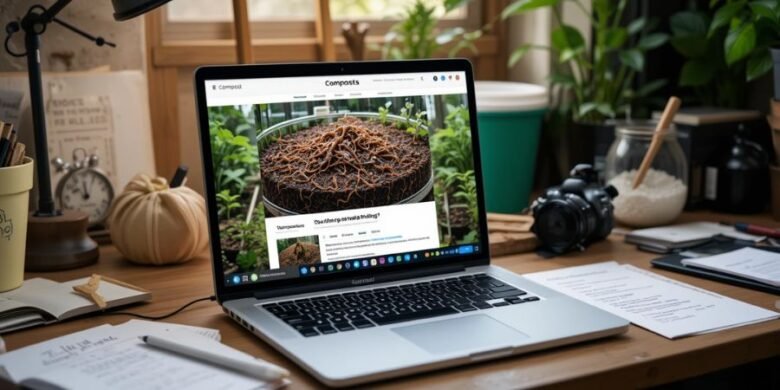Introduction
Worm farming is not just an eco-friendly practice; it’s a fascinating journey of sustainability and discovery. Sharing your worm farming experience through blogging and social media can inspire others, build a community, and even turn your passion into a business opportunity. In this guide, we’ll explore how to effectively document and share your worm farming journey, from creating engaging content to leveraging social media platforms.
Why Share Your Worm Farming Journey?
1. Inspire Others
- Educate people about the benefits of worm farming.
- Show how simple and rewarding it can be to start a worm bin.
2. Build a Community
- Connect with like-minded individuals who share your passion for sustainability.
- Exchange ideas, tips, and experiences with other worm farmers.
3. Promote Sustainability
- Advocate for eco-friendly practices and waste reduction.
- Encourage others to adopt vermiculture as part of their lifestyle.
4. Create Opportunities
- Establish yourself as an authority in worm farming.
- Explore monetization opportunities through workshops, product sales, or sponsorships.
Getting Started: Blogging About Worm Farming
1. Choose Your Platform
Select a blogging platform that suits your needs:
- WordPress: Ideal for detailed, customizable blogs.
- Medium: Great for straightforward content sharing.
- Blogger: Beginner-friendly and easy to set up.
2. Plan Your Content
Outline the topics you want to cover. Examples include:
- How to start a worm farm.
- Common challenges and solutions.
- The benefits of worm farming for the environment and gardening.
- Creative uses for worm castings.
Tip: Break down complex topics into a series of posts to keep your audience engaged.
3. Write Engaging Posts
- Start with a Hook: Use a relatable anecdote, a surprising fact, or a question to draw readers in.
- Be Informative: Include actionable tips and step-by-step guides.
- Add Visuals: Incorporate photos or diagrams of your worm bin, compost, or garden results.
- Keep It Conversational: Write in a friendly, approachable tone.
4. Optimize for SEO
Help people find your blog by optimizing it for search engines:
- Use keywords like “worm farming tips” or “how to compost with worms.”
- Write descriptive titles and meta descriptions.
- Include internal links to related blog posts.
Leveraging Social Media to Share Your Journey
1. Choose the Right Platforms
Focus on platforms where your target audience is active:
- Instagram: Share visually appealing photos and videos.
- TikTok: Post short, engaging clips of your worm farming process.
- YouTube: Create detailed tutorials and vlogs.
- Facebook: Join or start groups related to worm farming and composting.
- Pinterest: Share how-to guides and visually striking infographics.
2. Content Ideas for Social Media
- Before-and-After Photos: Show the transformation of waste into compost.
- Quick Tips: Share bite-sized advice, like “What to feed your worms.”
- Time-Lapse Videos: Capture worms breaking down organic material.
- Behind-the-Scenes: Show your daily worm farming routine.
- Success Stories: Highlight how worm farming has improved your garden or reduced waste.
3. Engage with Your Audience
- Respond to comments and messages promptly.
- Ask your audience questions, such as “What challenges do you face in composting?”
- Run polls or quizzes to encourage interaction.
Tips for Growing Your Online Presence
1. Be Consistent
Post regularly to keep your audience engaged. Create a content calendar to stay organized.
2. Collaborate with Others
Partner with fellow worm farmers, gardeners, or sustainability advocates to:
- Host joint live sessions.
- Share each other’s content.
- Co-create blog posts or videos.
3. Share Personal Stories
People connect with authenticity. Share your successes, failures, and lessons learned to build a relatable narrative.
4. Use Hashtags
Boost visibility by using relevant hashtags, such as:
- #WormFarming
- #CompostingTips
- #SustainableLiving
- #EcoFriendly
5. Analyze Your Performance
Use analytics tools to track your progress:
- Identify which posts resonate most with your audience.
- Adjust your strategy based on engagement metrics.
Monetizing Your Worm Farming Content
1. Sell Products or Services
- Offer worm farming starter kits, compost, or live worms.
- Host workshops or webinars to teach vermiculture techniques.
2. Partner with Brands
Collaborate with eco-friendly brands to promote products related to gardening, composting, or sustainability.
3. Create a Patreon or Membership Program
Offer exclusive content, such as in-depth guides or personalized consultations, to your supporters.
4. Earn from Ads and Affiliates
Monetize your blog or YouTube channel through ads or affiliate links for products you recommend.
Conclusion
Sharing your worm farming journey through blogging and social media is a powerful way to inspire others, build a community, and promote sustainable practices. With engaging content, consistent posting, and authentic storytelling, you can grow your audience and make a positive impact. Whether you’re blogging about tips and techniques or showcasing your composting adventures on Instagram, your journey can motivate others to embrace the world of worm farming. Start sharing today and join the global movement toward sustainability!




